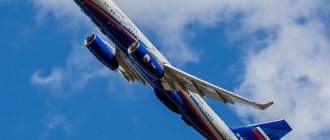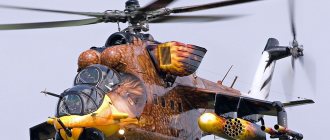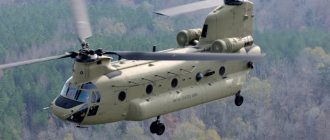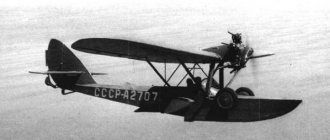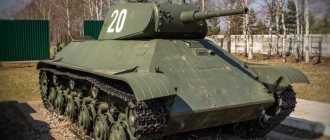This is the most recognizable “carcass”, since more than 850 units were produced with all modifications, mainly for the countries of the socialist camp. After testing was completed in 1964, the aircraft is still in service. I would like to tell you why it is so beautiful from an engineering point of view, and show photographs of a conditionally civil aircraft.
Tu-134A-3 aviation
Background
The first Soviet jet passenger aircraft was the Tu-104, which made its first flight in 1955 and has been making regular flights since 1956. In parallel, in France, Sud Aviation developed the SE210 Caravelle. The first flight of the Caravelle also took place in 1955, and the first flight with passengers - in 1959. A distinctive feature of this aircraft was the unusual location of the engines - on the sides of the rear fuselage on pylons.
Picture from Wikipedia of what Caravel III looks like
In 1955, the president of the South-Eastern Society of France for the construction of aircraft, J. Herail, proposed concluding a contract with the USSR for the supply of Caravelles. Although at this time the USSR was already preparing for serial production of the Tu-104, the Caravel was more advanced in terms of equipment, comfort and efficiency. And its purchase also made it possible to adopt advanced Western technologies, especially if it was possible to observe production, assembly and testing.
Correspondence on this topic continued until 1961, but the deal never took place. But the story didn't end there.
In January 1960 N.S. Khrushchev went on a state visit to France, and there he was taken for a ride on the Caravel. The head of the Soviet Union was impressed by the low level of noise and vibration in the cabin, since in a similar Soviet aircraft, the Tu-104, the engines were located in the wing near the fuselage and the vibration from them was felt in the cabin stronger than from the engines on separate pylons in the tail of the Caravel. Returning, he met with Tupolev and gave instructions to begin work on a similar aircraft.
Just at this time, the Tupolev Design Bureau was finalizing the short-haul Tu-124, similar to the reduced Tu-104. It was one of the world's first passenger aircraft equipped with turbojet engines. The Tu-124 made its first flight in March 1960 (began to operate in 1962). And Resolution of the Council of Ministers of the USSR No. 846-341, instructing OKB-156 to create a new BMS similar to the Caravel, was issued on August 1 of the same year. To simplify the task, the OKB decided to make a new aircraft based on the Tu-124. That is, the Tu-124 is outdated before it even went into production.
The new aircraft was designated Tu-124A. The fuselage with a glassed-in navigation cabin was taken almost entirely from the Tu-124. The engines were placed like on the Caravel, but the tail unit was made T-shaped, not cruciform.
This is what the tail unit and engines on the Tu-134 look like.
Interesting facts related to the plane
Considering that the TU-134 is one of the most mass-produced aircraft in the USSR, it gradually acquired its own legends.
But not all of them are fiction and here are some facts that really happened:
- One of the test flights of the airliner was carried out in bad weather conditions and the plane was hit by ball lightning. Moreover, she entered the cockpit and flew further into the cabin. The board was landed as usual and no serious consequences were found, not taking into account several melted parts and the skin riddled with small through holes.
- The aircraft is the first among Soviet aircraft to receive an international certificate of conformity.
- Being the basis of the aircraft fleet of the USSR government, it was equipped with various unique equipment. For example, L.I. Brezhnev’s plane had on board the Tatra communications complex, which made it possible to contact any telephone subscriber on Earth and was the most modern system of its kind at that time. And Defense Minister Grechko “showed off” the Karpaty satellite communications complex, which, in turn, made it possible to contact any person who had something resembling a means of communication at hand.
- Some of the aircraft that had flown off their service life were not disposed of, but were installed as monuments or museum exhibits in different cities of the USSR, and subsequently the Russian Federation. Thus, Murom, Voronezh, Poltava, Ulyanovsk, Riga, Moscow and others can boast of such a “sculpture”.
- It is the TU-134 that is present in the flight footage in the legendary Soviet film “The Irony of Fate or Enjoy Your Bath.”
This aircraft is, without exaggeration, an entire era of domestic aviation and the engineering thought of Soviet aircraft designers.
At one time, it appeared to be not just a modern car, its performance was significantly ahead of the corresponding characteristics of its Western counterparts.
Today, of course, it cannot compete with modern airliners, but we should not forget that many of the solutions used in their design were “tested” on the TU-134 “devil’s plane.”
Why move the engines to the tail?
This engine arrangement had many advantages:
- Aerodynamically clean wing. This made it possible to maximize the use of the wing span to accommodate flaps, increasing the aerodynamic quality of the wing.
- Improved lateral stability and handling characteristics. They were achieved due to the fact that the wing could be placed at the desired transverse V angle.
- With this arrangement, the engine nacelles and their pylons worked as an additional horizontal tail.
- The efficiency of the horizontal tail has increased, since it was moved out of the flow bevel zone behind the wing.
- The efficiency of the vertical tail was also improved by installing the horizontal tail at the top.
- The turning moment created by the thrust when one of the engines fails has decreased.
- Conditions for the operation of engine air intakes have been improved. Now the angle of approach of the air flow to the air intake did not change as much as when placing the engine under the wing or at the leading edge.
- From a fire safety point of view, things have also improved. The engines, located in the rear fuselage, are located away from the fuel tanks and the passenger compartment. If the engine catches fire, the flame will blow back in flight without catching the power elements of the aircraft structure. During an emergency landing, the engines are protected by the wing and fuselage from hitting the ground.
- The high location of the engines protected them from the ingress of any dirt and water when working on the ground. During taxiing, the engines are protected by flaps.
- Good conditions for approaching the engines. And the ability to quickly replace the entire nacelle along with the engine.
- Increased fatigue strength of the aircraft structure. Since it was now less influenced by the pulsating loads from the jet stream of the engines and the sound waves created by these jets.
- The low noise level in the cabin, which so impressed N.S. Khrushchev.
There were also some downsides:
- Additional modifications and an increase in the weight of the aircraft were required: 1) the rear fuselage required reinforcement due to loads from the engines; 2) the weight of the wing had to be increased, since the engines no longer unloaded it in flight; 3) due to the relocation of the engines, the alignment changed, the wing had to be moved back and the forward part of the fuselage had to be strengthened to compensate for the increased bending moment.
- Maintenance of the tail unit has become more difficult.
- The engine nacelles created additional drag.
- Due to the diving moment from the high-mounted engines, the lift-off speed of the nose gear became greater. The force on the steering wheel has increased.
Prototypes
USSR-45075
The main components of the first prototype were manufactured at the Kharkov aircraft plant No. 135, where the Tu-124 was mass-produced. The final assembly of the aircraft with serial number No. 00-00 took place at Moscow Machine-Building Plant No. 156. The aircraft received registration number USSR-45075. The first two digits of the number indicated the type of aircraft, where 45 corresponded to the Tu-124, although on February 20, 1963, by order of the OKB, the Tu-124A was renamed Tu-134.
The first flight of the Tu-134 prototype took place on July 29, 1963 in Zhukovsky. The crew commander was Hero of the Soviet Union, Honored Test Pilot A.D. Kalina, co-pilot - Honored Test Pilot E.A. Goryunov.
The passenger capacity of the first model was up to 56 people with a crew of 4-5 people. Factory tests ended on November 6, 1964. In 225 flights, the first prototype flew 274 hours.
USSR-45076
The second prototype No. 00-01 USSR-45076 was assembled in the summer of 1964. It was longer, heavier, with additional fuel tanks and a passenger capacity of up to 64 people. An automatic control system BSU-ZP was already installed here, providing an automatic approach to the ICAO category I meteorological minimum.
The first flight of USSR-45076 took place on September 9, 1964. Factory tests were carried out from February 20 to April 7, 1965 (36 flights, 60 hours), and in June of the same year this aircraft was already presented at the Le Bourget International Air Show. Immediately after the show, USSR-45076 flew to Berlin, Warsaw and Prague to receive orders from foreign airlines.
In July 1965, factory tests of the USSR-45076 were completed, and the board was transferred for testing to the Air Force Research Institute. During testing on January 14, 1966, the plane crashed due to a gross violation of flight regulations. At speeds above 0.84 M, the Tu-134 experienced a reverse roll response to rudder deflection, which the test pilot was unfamiliar with. Having brought the plane to a maximum speed of 0.86 M and deflected the rudder to a maximum angle of 25 degrees, the pilot created a strong roll in an unusual direction, which turned into a sliding on the wing and a dive. The small area of the elevators did not allow the aircraft to be brought out of the dive. After this incident, an operational speed limit of 0.82 M was established. And a spring mechanism was installed on the plane, limiting the deflection of the rudder in cruising flight to 5 degrees.
Salon Tu-134
The design features of previous versions of the Tu-134 include a glass nose (in the navigator’s place), and a brake flap under the center section. Modern versions of the aircraft are equipped with a "Groza-134" radar system. The Tu-134 also became the first jet aircraft in the USSR that did not use cable wiring to the rudder (as was usually done on previous models - the Tu-16 bomber and Tu-104 and Tu-124 passenger), installing a hydraulic booster and replacing it with a rigid rod.
Serial samples
Serial production of the Tu-134 began in 1966.
On July 21, 1966, Tu-134 USSR-65602 took off - the first copy with new D-30 engines and a take-off weight of 44 tons. There is no typo in the number, it really started with USSR-65***, this is already a Tu-134 from Kharkov assemblies. The previous two aircraft USSR-65600 and USSR-65601 were flown in August 1965, but they still had old D-20P-125 engines.
By October, USSR-65602 was modified, increasing the stabilizer area by 30%. This decision was made after the crash of the British BAC 1-11. The cause of the disaster was the peculiarity of the design with engines at the rear and horizontal tail surfaces at the top - at high angles of attack, the stabilizer fell into the wake from the wing, and upon emerging from it, it fell into the wake from the engine nacelles. After this incident, all the companies that made aircraft of this design began to increase the horizontal tail.
Since 1977, the ABSU-134 automatic approach system appeared on production copies, which made it possible to land according to the ICAO category II meteorological minimum. All production copies were built at Kharkov plant No. 135. Serial production continued until September 1984. The last regular flight of the Tu-134 took place on May 21, 2022. Now the plane continues to be used, but for official purposes.
Is it possible to buy
Currently, purchasing a Tu-134 is not difficult. If the aircraft is in flight shape and still suitable for operation, its commercial value is from 1 million euros or more. Thus, an A-3 modification aircraft in good condition can be purchased for €1,005,870 or, respectively, $1,200,000, 70,260,000 rubles.
But often a car is purchased to equip a restaurant or entertainment center. Then its cost is noticeably reduced, because the buyer buys practically scrap. Decommissioned cars are great for this.
However, these aircraft will soon become a rarity. Now only 120 machines are in operation and 100 of them are in the Russian Federation. Prudently themed museums and historical parks are already taking care of acquiring the legendary “carcass” for their arsenal.
Over its half-century history, the Tu-134 has demonstrated reliability and efficiency, meeting the requirements of the time. And small companies operating domestic medium-haul flights continue to use it. Tu-134s are purchased by flight schools for training flights. The airliner has found application not only in civil aviation; some of its modifications are used in military aviation. The Tu-134 is also used for private passenger transportation. Domestic businessmen who value their time find the optimal balance of price, reliability and comfort in this aircraft.
Crew
The crew is at work.
The aircraft crew consists of four people:
- Aircraft commander. Sits in the cockpit on the left side of the flight.
- The co-pilot sits on the right.
- The navigator has a workplace in the nose of the aircraft. The nose of the Tu-134A is transparent so that the navigator can provide visual orientation during flight.
- Flight mechanic - located in the aisle between the pilots' seats.
The cockpit provides an additional workplace for the flight radio operator (pilot) - in the aisle between the navigator and the pilots.
Navigator's workplace.
During the flight, passengers are served by two flight attendants. Seats for them are located in the crew vestibule, forward vestibule and at the end of the passenger cabin.
Cabin
It's better to see once than to read a hundred times.
Placement of elements of the first pilot's control systems. On the left is a scan of the book “Tu-134 Aircraft. Design and operation"
The first pilot's instrument panel. On the left is a scan of the book “Tu-134 Aircraft. Design and operation".
Middle dashboard. On the left is a scan of the book “Tu-134 Aircraft. Design and operation".
Upper electrical panel of the cockpit. On the left is a scan of the book “Tu-134 Aircraft. Design and operation".
Co-pilot's instrument panel. On the left is a scan of the book “Tu-134 Aircraft. Design and operation".
Transition to intra-Union use
In the late 60s and early 70s, the main field of operation of the TU-134 aircraft remained international routes. Among the intra-Union routes, only 12 were closed by this airliner - from the capital to the largest cities of the country.
The turning point was the year 1972, the May of which was marked by a serious tragedy involving the An-10, which was the main aircraft on domestic airlines. The crash killed 112 people.
An urgent decision is made to temporarily abandon the use of the An-10, until the causes of the plane crash are clarified and analyzed, and it is replaced by the TU-134. However, the airstrips of many Soviet cities were not designed for the landing and takeoff of the airliner and the order was given for their immediate re-equipment.
The investigation into this plane crash led to the fact that a year later - in 1972 - a decision was made to abandon the use of the An-10 altogether.
However, there were not enough 134s for all directions, which led to their replacement at the capital’s airports with the newly arrived medium-haul TU-154 and Il-62, designed for long-haul flights.
In 1980, the aircraft received another update, designated TU-134B. The changes affected the number of passenger seats, which increased to 96, and the take-off weight, increased to 47,000 kg. In addition, it was decided to completely abandon the navigator.
Next in line was another project with the “D” index, which involved installing modernized power plants with increased thrust on the airliner, but it did not see the light of day due to the complete cessation of production of the “tupolenka” in 1989. However, during this time modifications were created for a variety of needs, including military ones.
An example is the TU-134, on which the navigators of long-range and attack aviation crews performed training in strategic interaction and bombing.
Over the entire period of its production, that is, from 1966 to 1989, all passenger varieties of TU-134 aircraft transported about half a billion people. Its gradual decommissioning was due to the acquisition of new, more economical and modern machines. Another reason was the simple obsolescence of the “whistles”.
For example, due to the introduction by the European Union of new standards for the level of “noise” of aircraft in the 2000s, it was necessary to abandon the use of the airliner on foreign routes.
Today, these aircraft are practically no longer used even on local airlines - they are morally and structurally outdated.
Fans of the domestic aircraft industry have created a special registry of aircraft, in which you can see where else you can find this or that aircraft today, including the TU-134. This list can easily be found on aviation enthusiast forums.
Rescue equipment
Emergency exits
This is what the plane was equipped with in case of an accident:
- Inflatable ladder at the front door. The emergency disembarkation of 72 passengers using one inflatable ladder ideally took 3-4 minutes.
- Avisent chute - if it is impossible to use an inflatable ladder due to a fire at the front door.
- Rescue ropes above all escape hatches. There are four hatches, left and right above the wing. There are knots on the rescue ropes every half meter to prevent getting burned during the descent.
- Two emergency radios in the crew lobby.
- Passenger rafts for 12 people, inflatable boats for 5 people and individual life jackets for flights over water.
- Two emergency hatchets. Just in case.
Modifications
During serial production, several modifications appeared:
Tu-134K
K means comfort. It was flown by the USSR government. And not only. For example, the governments of Hungary and Iraq flew export Tu-134Ks.
Tu-134A
Tu-134 variant with an extended fuselage, increased passenger capacity and an expanded front luggage compartment. The crew was reduced by one person - the radio operator was removed, and the pilots began to be responsible for radio communications. Rescue ropes were added to the rescue equipment at the emergency hatches and pilot canopy windows.
The Tu-134A, produced before the end of March 1978, had a landing flap under the fuselage, which allowed it to approach with a glide path of up to 9 degrees. With the advent of automatic approach systems, the flap is no longer needed, since the automatic glide path has an angle of 3 degrees.
The Tu-134A had its own modifications:
• Tu-134AK
The main difference from the Tu-134A is an additional entrance door with a folding ladder in front of the left engine. In front of the plane there were a couple of salons “for the main passenger”, in the rear there were general salons. The radio operator's workplace was returned to the pilot's cockpit.
That extra door with a folding ladder.
A salon for very important passengers.
• Tu-134A-1 with the Groza-M134 radar instead of the navigation cabin
Produced for export only. This Tu-134A flew with a crew of three people. The functions of the navigator were performed by the co-pilot. Soviet pilots were in no hurry to give up the navigator and even on the returned planes with the “Groza” they continued to fly four of them.
• Tu-134A-2
It was equipped with more economical D-30-II engines (second series) with reverse, which made it possible to abandon the braking parachute. The TA-8 auxiliary power unit, designed specifically for this aircraft, was installed in the vacant space.
• Tu-134A-3 with D-30-III engines
• Tu-134B
Here the Groza-M134 weather radar was already standard equipment. The pilot's cockpit was also modified. The Tu-134B also had modifications:
- Tu-134B-1 increased capacity,
- Tu-134B-3 with D-30-III engines.
Non-passenger modifications
In addition to passenger modifications, specialized versions of the Tu-134 were also created, such as:
- agricultural Tu-134СХ,
- transport and sanitary Tu-134TS,
- training and navigator Tu-134Sh,
- Tu-134UBL (trainer similar to Tu-134B for pilot training)
- and many other modifications for various tasks.
Tu-134UBL, Vicki.
Specifications
The performance characteristics of the most common modifications of the TU-134 are presented in the following table:
| "A" | "B" | "SH" | |
| Dimensions | |||
| Length, m | 37,1 | ||
| Wingspan, m | 29 | ||
| Height, m | 9,02 | ||
| Fuselage diameter, m | 2,9 | ||
| Number of seats | |||
| Crew | 4 | 3 | 3 |
| Boarding | 68 | 80 | 12 |
| 1st class | 8 | 8 | — |
| Possible load | |||
| Take-off, t | 43 | 47,6 | 47 |
| Commercial, t | 8,2 | 9 | — |
| Landing, t | 43 | 43 | 43 |
| Fuel reserve, t | 14,4 | 13,2 | 16,5 |
| LTH | |||
| Cruising speed, km/h | 850 | 880 | 885 |
| Maximum range, km | 2100 | 2020 | 1890 |
| Ceiling height, m | 12100 | 10100 | 11900 |
| Required length of runway, m | 2200 | 2550 | 2200 |
| Average take-off time, seconds | 56 | ||
As can be seen from the table, the difference in modifications is minimal, with the exception of seats, of course.
More interesting things
- The first prototype of the Tu-134 USSR-45075 became an exhibit at VDNKh in 1968, and in 1977 it was installed in the courtyard of Moscow vocational school No. 164. And it stood there until 2013 (sawed in 2013).
- Soviet aircraft from the time the Tu-124A was created did not yet have reversible engines, so the Tu-124A had a braking parachute.
- On the first prototype of the Tu-134, like on the Tu-124, there were no emergency exits. Two emergency exits appeared for the first time on the pre-production aircraft USSR-65600 and USSR-65601. And the second pair of emergency exits appeared starting with the fourth production copy of USSR-65607.
- Electricity for the “kitchen” appliances was connected to the on-board network using a switch on the navigator’s electrical panel. And it turned off when the stabilizer deicer was turned on.
- The Tu-134 toilet has a porthole.
- The interiors were decorated in four color options: “sunny” – in greenish tones; “northern” – in gray-blue tones; “dream” – in blue tones; “turquoise” – in gray-cream tones.
Sources
: Airplane Tu-134. Construction and operation. V.A. Borodenko, L.V. Kolomiets. Magazine "Aviation and Time" 2.2010. Magazine “Wings of the Motherland” 11.1997. Some of the photographs without captions are mine, some are by Milfgard.
Aircraft accidents
Over the entire history of this aircraft model, about 70 Tu-134 aircraft were lost. At the same time, 9 units were shot down in connection with the war. One of them was shot down due to terrorist activities. According to statistics, approximately 1,500 people were injured while flying on this plane. The largest of them:
- In 1966, the ship was tested, in which it sharply reduced its altitude. This was due to a crew error. As a result, 8 people died.
- In 1971, due to a bad landing in Rijeka, all the people on board the ship died.
- In 1971, 49 people died. In 1972, due to an oversight by the pilot, the device crashed into the water (the number of victims is unknown).
- In 1975, there was an accident in Leipzig that led to the death of 21 passengers. During the descent, the crew did not measure the indicators, and the ship collapsed on the landing strip. The surviving crew members were convicted and received various punishments.
- In 1979, accidents occurred in Romania, Bulgaria and Liepaja. There were 94 casualties in the first ship and 84 in the second.
- In the 1970s and 1980s, planes crashed due to pilot errors. And in the 1990s, the technology fails. Most aircraft are "crossed out" after poor repairs.
- The last large-scale plane crash happened in 2007 in Samara. 6 passengers died in this plane crash. In the same year, the Moscow-Petrozavodsk flight crashed and took 44 lives to the next world.
In 2013, only 130 aircraft of this model were used. At this point, they began to be actively decommissioned, because each of them had served for more than 30 years. The best preserved aircraft serve as monuments. There is such an exhibit in Moscow, which is installed at VDNKh.
During their long and reliable service, these aircraft showed high fuel efficiency, which was highly valued in those days. Until 1990, the Tu-134 transported more than 450 million people. Some models are used for rural and military purposes. There are models that are equipped with a special connection. They transported command personnel. This aircraft is on the list of the best aircraft in the world. Since 2015, the operation of these aircraft has ceased.
Photo of the TU-134 cabin
Photo of the TU-134 interior
https://youtube.com/watch?v=mYDXzZ5ctzg%3Fenablejsapi%3D1%26autoplay%3D0%26cc_load_policy%3D0%26iv_load_policy%3D1%26loop%3D0%26modestbranding%3D0%26rel%3D1%26showinfo%3D1%26fs%3D1% 26theme%3Ddark%26color%3Dred%26autohide%3D2%26controls%3D2%26playsinline%3D0%26

